Ditapis dengan
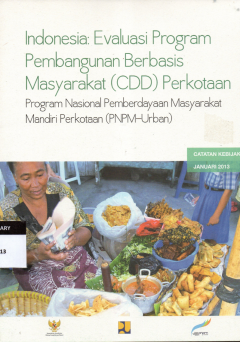
Indonesia: Evaluasi program Pembangunan Berbasis Masyarakat (CDD) Perkotaan: …
Program Nasional Pemberdayaan Masyarakat Mandiri Perkotaan (PNPM-Urban) merupakan inisiatif pemerintah Indonesia dalam mendorong pembangunan berbasis masyarakat di wilayah perkotaan. Program ini bertujuan untuk meningkatkan partisipasi masyarakat dalam perencanaan, pelaksanaan, dan pemantauan proyek-proyek pembangunan lokal, serta untuk mengurangi kesenjangan sosial dan ekonomi di kota-kota Ind…
- Edisi
- -
- ISBN/ISSN
- -
- Deskripsi Fisik
- viii, 24 halaman
- Judul Seri
- Textbook
- No. Panggil
- 306.3 BAK i
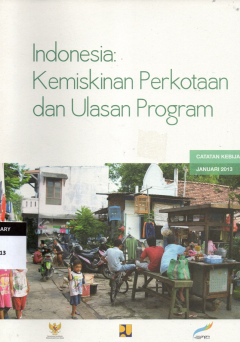
Indonesia: Kemiskinan Perkotaan dan Ulasan Program
Indonesia telah menunjukkan peningkatan substansial dalam indikator ekonomi dan sosial selama satu dekade terakhir, disertai dengan pengurangan kemiskinan secara bertahap di wilayah perkotaan dan perdesaan. Meskipun pencapaian ini mengesankan, 13 persen penduduk masih hidup dalam kemiskinan, dan 40 persen rumah tangga lainnya hidup sedikit di atas garis kemiskinan dan rentan untuk jatuh ke dala…
- Edisi
- Catatan Kebijakan Januari 2013 (Indonesia Ver.)
- ISBN/ISSN
- -
- Deskripsi Fisik
- x, 30 halaman
- Judul Seri
- Textbook
- No. Panggil
- 362.5 BAK i
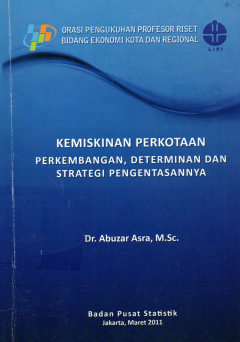
Kemiskinan Perkotaan: Perkembangan, Determinan dan Strategi Pengentasannya
Kemiskinan perkotaan merupakan fenomena kompleks yang mempengaruhi banyak aspek kehidupan masyarakat di kota. Studi ini bertujuan untuk menyelidiki perkembangan kemiskinan perkotaan, faktor-faktor yang memengaruhinya, serta strategi yang efektif untuk mengurangi tingkat kemiskinan di wilayah perkotaan.
- Edisi
- -
- ISBN/ISSN
- 978-979-064-268-3
- Deskripsi Fisik
- ii + 57 halaman; 15 x 21 cm
- Judul Seri
- Textbook
- No. Panggil
- 362.5 ABU k

The State of the World's Children 2012: Children in Urban World
The experience of childhood is increasingly urban. Over half the world’s people – including more than a billion children – now live in cities and towns. Many children enjoy the advantages of urban life, including access to educational, medical and recreational facilities. Too many, however, are denied such essentials as electricity, clean water and health care – even though they may liv…
- Edisi
- -
- ISBN/ISSN
- -
- Deskripsi Fisik
- 13 halaman ; ilustrasi berwarna
- Judul Seri
- Textbook
- No. Panggil
- 305.23 UNI s
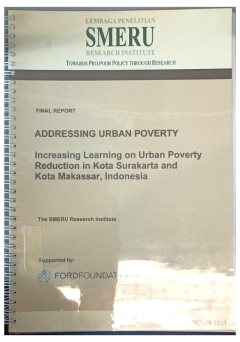
Addresing Urban Poverty: Learning on Urban Poverty Reduction in Kota Surakart…
With the growing intensity of urban problems, most notably poverty, it is imperative to identify the range of related aspects that help or hinder urban poverty reduction efforts. One emerging aspect is the role of city spatial planning in urban poverty reduction efforts. With the support from Ford Foundation, The SMERU Research Institute conducted a study to understand the connection between ci…
- Edisi
- Final Research Report
- ISBN/ISSN
- -
- Deskripsi Fisik
- vi, 86 Halaman ; ilustrasi
- Judul Seri
- Addresin Urban poverty
- No. Panggil
- 362.5 SME a
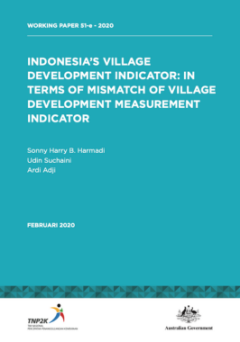
Indonesia’s Village Development Indicator: In Terms Of Mismatch Of Village …
The aim of this paper is to analyse the achievement of village development indicators in 2014 and 2018 after the release of Rp 250 trillion in Village Funds since 2015. There are three indicators related to village development in Indonesia, namely the Geographical Difficulty Index (Indeks Kesulitan Geografis: IKG) which is used as the basis for the Allocation Formula of the Village Fund and the…
- Edisi
- WORKING PAPER 51-e - 2020
- ISBN/ISSN
- -
- Deskripsi Fisik
- PDF, 36 Halaman
- Judul Seri
- Working Paper
- No. Panggil
- 307.72 HAR. I
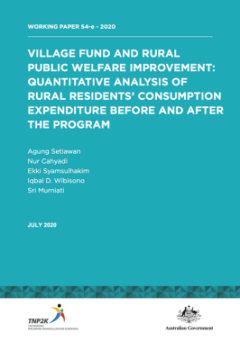
Village Fund And Rural Public Welfare Improvement: Quantitative Analysis of R…
The main finding of this study indicates that the Village Fund program has caused an increase in rural residents’ per capita expenditure. This study also finds that the magnitude of this increase in per capita expenditure varies by regional characteristics. Firstly, per capita expenditure in areas having good infrastructure is higher compared to per capita expenditure in areas having poorer i…
- Edisi
- Working Paper 54-e - 2020
- ISBN/ISSN
- -
- Deskripsi Fisik
- PDF, 20 Halaman
- Judul Seri
- Working Paper
- No. Panggil
- 307.72 SET. V
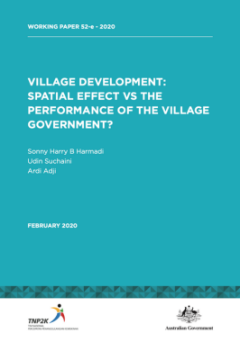
Village Development: Spatial Effect Vs The Performance Of The Village Governm…
Village funding in the amount of Rp 257.2 trillion in the past five years (2015-2019) uses a scheme that shares funding equitably. This is evident from the proportion of village funds (90 percent) that was divided equally (2015-2017) (Ministry of Finance, November 2017). This study aims to prove that the achievements of village development are not only due to the impact of the Village Fund Prog…
- Edisi
- Working Paper 52-e - 2020
- ISBN/ISSN
- -
- Deskripsi Fisik
- PDF, 38 Halaman
- Judul Seri
- Working Paper
- No. Panggil
- 307.72 HAR. V
 Karya Umum
Karya Umum  Filsafat
Filsafat  Agama
Agama  Ilmu-ilmu Sosial
Ilmu-ilmu Sosial  Bahasa
Bahasa  Ilmu-ilmu Murni
Ilmu-ilmu Murni  Ilmu-ilmu Terapan
Ilmu-ilmu Terapan  Kesenian, Hiburan, dan Olahraga
Kesenian, Hiburan, dan Olahraga  Kesusastraan
Kesusastraan  Geografi dan Sejarah
Geografi dan Sejarah